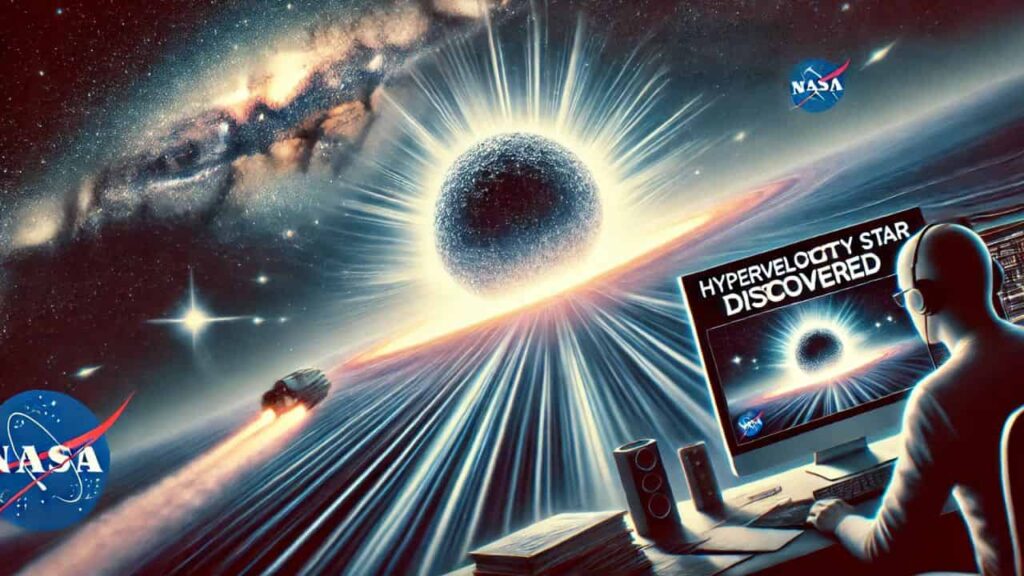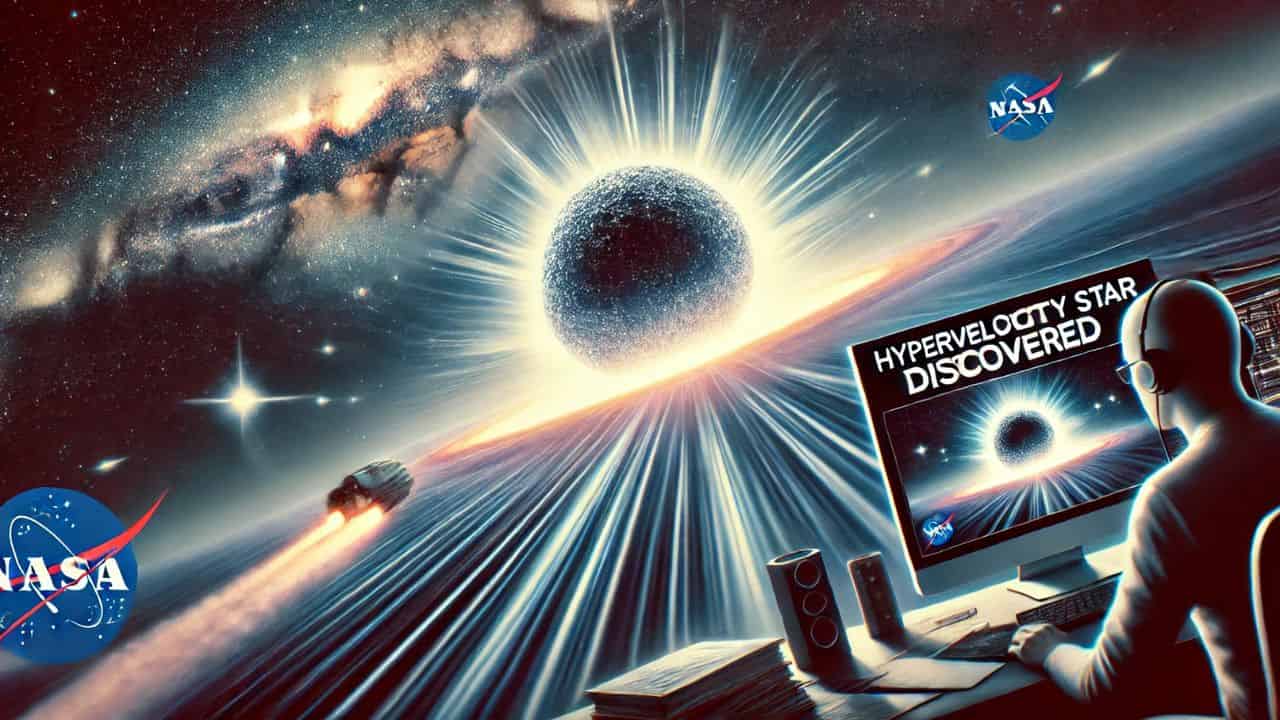NASA discovery, hypervelocity object, Backyard Worlds, citizen scientists, CWISE J124909.08+362116.0, Milky Way, WISE mission, brown dwarf, space exploration, intergalactic space, high-speed star
Citizen scientists from NASA’s Backyard Worlds: Planet 9 project have made an extraordinary discovery—a hypervelocity object moving at 1 million miles per hour, destined to escape the Milky Way’s gravity. Learn about this groundbreaking find, its unique characteristics, and the implications for our understanding of the universe.

NASA Citizen Scientists Discover Hypervelocity Object Traveling at 1 Million Miles Per Hour
In a remarkable discovery that has captured the attention of the astronomical community, citizen scientists participating in NASA’s Backyard Worlds: Planet 9 project have identified an object moving at an astonishing speed of 1 million miles per hour. Unlike the familiar stars that peacefully orbit the center of the Milky Way, this newly discovered object is on a trajectory that will see it escape the galaxy’s gravitational pull and shoot into intergalactic space. This hypervelocity object is particularly noteworthy as it is the first of its kind to be found with a mass similar to or less than that of a small star, making it a significant find in the field of astronomy.
The Backyard Worlds: Planet 9 Project
The Backyard Worlds: Planet 9 project is an innovative citizen science initiative that leverages the power of crowdsourcing to explore data from NASA’s WISE (Wide Field Infrared Explorer) mission. Initially launched in 2009, WISE mapped the sky in infrared light until 2011. In 2013, it was reactivated as NEOWISE (Near-Earth Object Wide-field Infrared Survey Explorer) and continued its mission until it was retired on August 8, 2024. This project has allowed thousands of volunteers to sift through vast amounts of astronomical data, leading to numerous discoveries, including brown dwarfs and other celestial objects.
Discovery of CWISE J124909.08+362116.0
The discovery of the hypervelocity object, designated as CWISE J124909.08+362116.0, was made by three dedicated citizen scientists: Martin Kabatnik, Thomas P. Bickle, and Dan Caselden. These volunteers spotted the faint, fast-moving object in the WISE images, which appeared to be marching across their screens at an unprecedented speed. Intrigued by the object’s velocity, they conducted follow-up observations using several ground-based telescopes to confirm their discovery and better understand its characteristics.
The object, commonly referred to as CWISE J1249, is zooming out of the Milky Way at a speed of about 1 million miles per hour. This velocity is extraordinary, especially given the object’s low mass, which makes it challenging to classify. Scientists are still debating whether CWISE J1249 is a low-mass star or a brown dwarf. If it doesn’t steadily fuse hydrogen in its core, it would be considered a brown dwarf, placing it somewhere between a gas giant planet and a star.
Unique Characteristics of CWISE J1249
Brown dwarfs are not uncommon in the universe; in fact, the Backyard Worlds: Planet 9 project has already uncovered more than 4,000 of them. However, CWISE J1249 is unique in several ways. Firstly, it is the only known brown dwarf (or low-mass star) on a trajectory to leave the Milky Way. This alone sets it apart from the thousands of other brown dwarfs discovered by the project.
Additionally, CWISE J1249 has a distinct elemental composition. Data obtained from the W. M. Keck Observatory in Maunakea, Hawaii, revealed that the object contains much less iron and other metals compared to other stars and brown dwarfs. This low metallicity suggests that CWISE J1249 is quite ancient, likely originating from one of the first generations of stars in our galaxy. The discovery of such an old object adds another layer of intrigue to its already fascinating story.
Theories Behind the High Velocity of CWISE J1249
The high velocity of CWISE J1249 has puzzled scientists, leading to several hypotheses about its origin. One possibility is that the object was once part of a binary system with a white dwarf. In such a system, the white dwarf could have exploded as a supernova after accumulating too much material from its companion. The explosion could have provided the necessary force to eject CWISE J1249 from the system at an incredible speed.
Another hypothesis suggests that CWISE J1249 originated from a globular cluster, a tightly bound group of stars. In this scenario, a chance encounter with a pair of black holes could have flung the object out of the cluster and into intergalactic space. According to Kyle Kremer, an incoming assistant professor in UC San Diego’s Department of Astronomy and Astrophysics, “When a star encounters a black hole binary, the complex dynamics of this three-body interaction can toss that star right out of the globular cluster.”
Further analysis of the object’s elemental composition will be crucial in determining which of these scenarios is more likely. By studying its metallicity and other characteristics, scientists hope to uncover more clues about its origins and the forces that propelled it to such extraordinary speeds.
The Role of Citizen Scientists in the Discovery
The discovery of CWISE J1249 is a testament to the power of citizen science. The Backyard Worlds: Planet 9 project relies on volunteers from around the world to examine data from the WISE mission, and their contributions have led to numerous discoveries. In this case, the collaboration between citizen scientists and professional astronomers was instrumental in identifying and characterizing the hypervelocity object.
Martin Kabatnik, one of the citizen scientists who discovered CWISE J1249, expressed his excitement about the find. “I can’t describe the level of excitement,” he said. “When I first saw how fast it was moving, I was convinced it must have been reported already.” Kabatnik credits other citizen scientists with helping him in the search, including Melina Thévenot, who provided valuable insights through her personal blog on using Astronomical Data Query Language. Additionally, software developed by citizen scientist Frank Kiwy played a crucial role in the discovery.
The study on CWISE J1249, led by Backyard Worlds: Planet 9 science team member Adam Burgasser, a professor at the University of California, San Diego, includes several co-authors who began their astronomy careers as citizen scientists. This collaborative effort underscores the importance of involving the public in scientific research and demonstrates how amateur astronomers can make significant contributions to our understanding of the universe.
Implications of the Discovery
The discovery of CWISE J1249 has several important implications for the field of astronomy. First and foremost, it challenges our understanding of hypervelocity objects. Until now, most known hypervelocity stars were massive and easily distinguishable. The identification of a hypervelocity object with a mass similar to or less than that of a small star opens up new avenues of research and raises questions about the processes that can accelerate such objects to extreme speeds.
Furthermore, the discovery highlights the importance of studying low-mass stars and brown dwarfs in greater detail. While these objects are often overlooked in favor of more massive stars, they can provide valuable insights into the early history of the galaxy and the dynamics of star systems. The unique properties of CWISE J1249, including its low metallicity and high velocity, suggest that it may hold clues to the formation and evolution of the Milky Way.
Finally, the discovery underscores the potential of citizen science in advancing our understanding of the universe. Projects like Backyard Worlds: Planet 9 demonstrate that with the right tools and guidance, amateur astronomers can make significant contributions to the field of astronomy. As technology continues to improve and more data becomes available, the role of citizen scientists in astronomical research is likely to grow.
Conclusion
The discovery of CWISE J124909.08+362116.0 by citizen scientists working on NASA’s Backyard Worlds: Planet 9 project is a groundbreaking achievement. This hypervelocity object, traveling at 1 million miles per hour, is not only the first of its kind to be found with a low mass, but it also challenges our understanding of how such objects are formed and propelled. The collaboration between amateur astronomers and professional scientists has been crucial in making this discovery, highlighting the value of citizen science in advancing our knowledge of the universe.
As scientists continue to study CWISE J1249, they hope to uncover more about its origins and the forces that have driven it to such extraordinary speeds. This discovery serves as a reminder that even in the vastness of space, there is still much to learn, and that with the help of citizen scientists, we can continue to explore and uncover the mysteries of the cosmos.
Read More
- NASA and Sierra Space Dream Chaser Arrives in Florida for Launch Prep
- NASA Artemis Generation: Cultivating the Moon Trees Across America
- NASA Engages Connecting Communities with Space and STEM Experts
- NASA’s Select Terrain Vehicle for Artemis Missions










